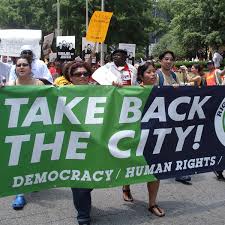 So we’re in crisis. Things are bad. In my last post, I gave you Davies and Marcuse presenting two takes on the whys and hows of that. And they weren’t all that different.
So we’re in crisis. Things are bad. In my last post, I gave you Davies and Marcuse presenting two takes on the whys and hows of that. And they weren’t all that different.
What is different is that Davies critique is limited to lthe existing system, he cannot see beyond it. He combines a cautious optimism that we can correct all of this — that something simply went very wrong in a system that is perfectly all right — with the notion that the right technical fixes can leave all of that behind us.
Marcuse, on the other hand looks beyond, as should anyone who has lived through the many crises that our economy has rocked and who wants to know why inequality is rising astronomically.
So where does Marcuse think that we who live in the city actually want to go? And how do we get there?
Good City vs Just City
For a while some intellectuals talked about the “Good City.” A biblical reference, an ideal of what could be but lacking in a way to arrive there, utopia.
There’s also the idea of the “Just City.” On its face none of us would disagree with some justice. But this has been limited to the goal of inclusion, with the idea that with a more fair distribution of goods and services, maybe we could even manage opportunities. But don’t rock the boat too much. The system we have is a good one. It just needs a little tweaking.
You can tell I don’t like that one! Neither does Peter Marcuse. So what then? What is neither utopian nor rigidly practical and self-limiting?
The Right to the City
The Right to the City, coined by Henri Lefebvre (and please do read Lefebvre, he’s been rocking my world lately –particularly State, Space, World, which is sitting half-read on my desk even now). Lefebvre’s Right to the City is the right to an alternative system, the right to construct an alternative vision of what could be. It is a right that must be demanded, and a vision of radical democracy where we all collectively create our communities together with the rest of our neighbors and those who actually live here.
Some people already have this right. The very wealthy primarily. We need to be clear that this campaign is not for them, it is to ensure that everyone has power in the city. I agree with Marcuse that this is important.
And where does the campaign come from?
Marcuse argues that there are two groups who will drive this, and begs forgiveness for the inadequacy of the titles. These are:
- The deprived. The unemployed, the exploited, the poor. Primarily people of colour.
- The discontented. The artists, the intellectuals, those who see the deep injustice of the world and feel a need to do something about it.
The Role of Theory
And what is the role of theory in this endeavor? Critical urban theory is the glue. It is required to build the mutual understanding of how and why these two different groups need to come together, not to mention the multiple subgroups contained within each of them. We need to come together and fight for our right to the city.
I’m mostly all for it, and I’m sure you shall be hearing more about Right to the City. Marcuse even gave a shout out to the American alliance of that name. Having been at the founding that made me happy.
For me, however, it is pivotal that those who Marcuse calls the deprived be the drivers.
Those who suffer most from having no rights to their city should be the ones to frame the question and push forward the process of radical democracy that Lefebvre argues is the key factor towards the New City.
It is to these demands and this process that the discontented need to ally themselves.
And theory needs to dialogue with both in a way that builds each, while at the same time building something entirely new and beautiful.
